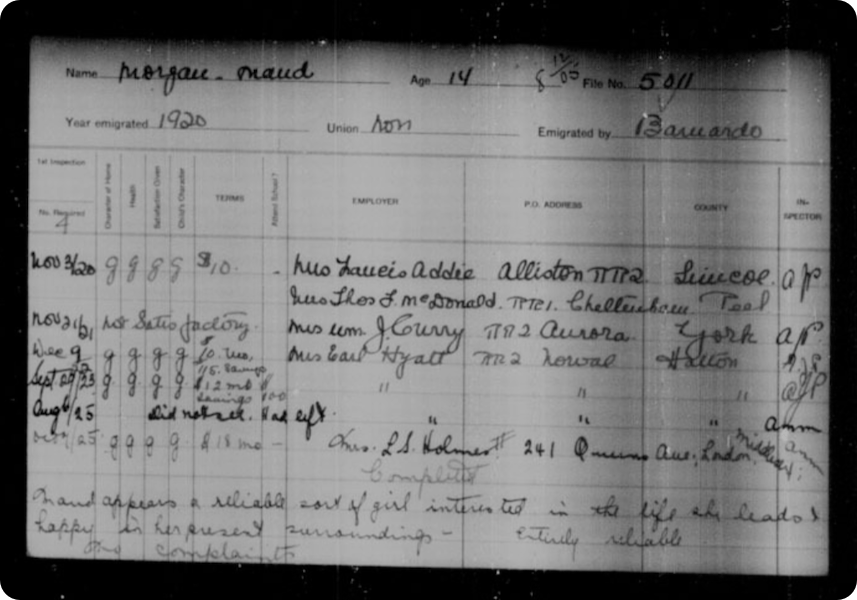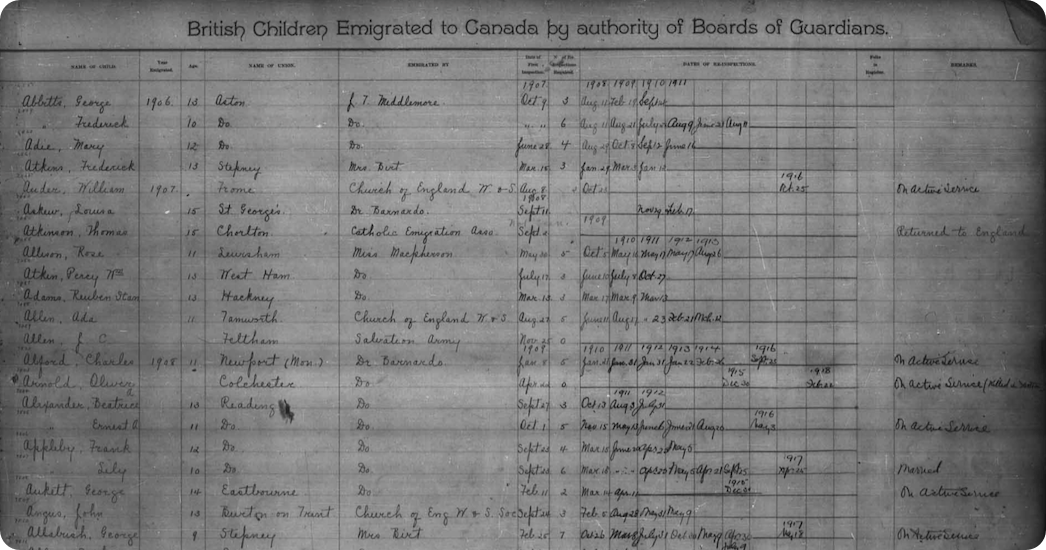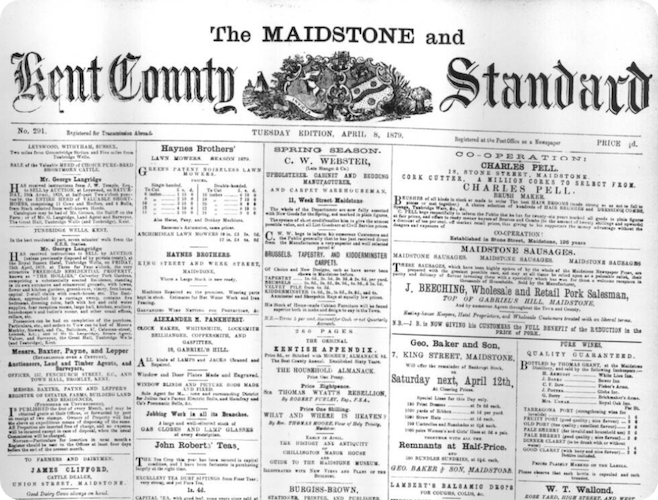Introducing the British Home Children Collection
4-5 minute read
By Daisy Goddard | March 1, 2024

This Findmypast Friday, discover moving stories that span the globe.
With this week's extensive record update, we're shining a light on one of history's often-forgotten chapters. Published in partnership with Library and Archives Canada, these four new sets of educational, work and travel records tell the story of Britain's Home Children - over 130,000 vulnerable and impoverished minors who were sent to live overseas in the 19th and 20th centuries.
We've also added over 260,000 new pages to our newspaper collection - read on to learn more about everything that has joined Findmypast this week.
The British Home Children Collection
Between the 1860s and 1970s, over 130,000 children were sent to live in overseas dominions by the British government. Known as British Home Children, many of their stories have been lost to history.
You can learn more about British Home Children here. Discover the programme's origins, the conditions faced by the children involved and its legacy in the present day.
Canada, Home Children Inspection Reports
This brand new set - which contains 25,534 images and transcriptions - is taken from the inspection report cards used by Canadian immigration officials to record key information about Home Children.

The inspection record of Maude Morgan, who emigrated with Dr Barnardo's aged 14 in 1920. View this record.
Covering between 1913 and 1932, this collection is key for determining where a child was living at a particular point in time. Between the transcription and the original record image, you can expect to learn the child's name and age, as well as the year of their emigration and the sending organisation.
Canada, Home Children Board Of Guardian Records
Our second new Home Children collection is taken from workhouse registers. There are 10,678 transcriptions and images, covering 36 years.
Each record will typically tell you the child's name and age, the place where they were taken into care in England and the organisation that sent them overseas. There is an additional section for notes on each record - so be sure to check the detail-rich image for any details that the transcription may have missed.
Lancashire, Liverpool, Children Sent To Canada 1883-1925
Spanning 1883 to 1925, this new set contains 466 records which identify Home Children that were sent from Liverpool to Canada.
The registers that these records are taken from are organised by religion, but you can search them by name, date and optional keywords.
You'll typically be able to glean a name, birth year, age at time of immigration, workplace and religious denomination.
Britain, Children's Legislation Correspondence
Lastly, we've also added an interesting collection of documents which relate to the passing of the Children's Act in 1908, available to browse only.
With rich sources like letters between government officials and pamphlets produced by children's organisations included, these 2,062 documents provide important context for researching Home Children.
New pages from Croydon to the Caribbean
Our newspaper archive grew by 247,740 pages this week, with a duo of new English titles added - the Kent County Standard and the Kent Evening Post.
But the new pages don't end there. We've also updated 69 of our existing publications from across the world, including titles from Ireland, the Channel Islands, New Zealand, Hong Kong and the Caribbean.
Wherever on the globe your roots stretch to, be sure to explore the fascinating stories contained within this week's new pages.
Here's a full rundown of all that we've added this Findmypast Friday.
New titles:
- Kent County Standard, 1875-1881, 1883-1890
- Kent Evening Post, 1970-1972, 1974-1980, 1985-1989, 1991-1992, 1995-1997
Updated titles:
- Alloa Journal, 1916
- Arbroath Herald, 1963
- Banffshire Advertiser, 1916
- Banffshire Herald, 1916
- Barrhead News, 1916
- Bolton Evening News, 1916
- Broughty Ferry Guide and Advertiser, 1979-1980
- Cambrian News, 1916
- Coalville Times, 1916
- County Express, 1916
- Croydon Times, 1963
- Cumberland & Westmorland Herald, 1916
- Dalkeith Advertiser, 1963
- Deal, Walmer & Sandwich Mercury, 1999
- Denbighshire Free Press, 1916
- Derbyshire Times, 1963
- Dominica Chronicle, 1916
- East End News and London Shipping Chronicle, 1963
- Essex Weekly News, 1916
- Evening Irish Times, 1915-1916
- Forres Elgin and Nairn Gazette, Northern Review and Advertiser, 1916
- Glossop-dale Chronicle and North Derbyshire Reporter, 1914, 1916
- Hants and Sussex News, 1916
- Hemel Hempstead Gazette and West Herts Advertiser, 1986
- Holloway Press, 1963
- Hornsey & Finsbury Park Journal, 1916
- Huntly Express, 1916
- Irish Weekly and Ulster Examiner, 1963
- Jersey Evening Post, 1916
- Kentish Express, 1974, 1984, 1987
- Leven Mail, 1963
- Lewisham Borough News, 1963
- Lincolnshire Chronicle, 1833-1835, 1856, 1861, 1872-1873, 1877, 1879-1880, 1888-1891, 1898, 1912, 1914, 1920, 1931, 1933, 1940-1954
- London Evening Standard, 1916
- Londonderry Sentinel, 1998
- Lowestoft Journal, 1916
- Lyttelton Times, 1914
- Maidstone Telegraph, 1971-1973, 1980, 1986-1987, 1999
- Melton Mowbray Times and Vale of Belvoir Gazette, 1917, 1921, 1929-1930
- Midland Tribune, 1916
- Montrose Standard, 1963
- Morecambe Visitor, 1912
- Munster Tribune, 1963
- Northern Chronicle and General Advertiser for the North of Scotland, 1916
- Northern Scot and Moray & Nairn Express, 1916
- Nuneaton Observer, 1916
- Orcadian, 1916
- Overland China Mail, 1916
- Port-Glasgow Express, 1963
- Porthcawl Guardian, 1963
- Reading Standard, 1963
- Richmond and Twickenham Times, 1916
- Sheerness Times Guardian, 1993
- South Eastern Gazette, 1972, 1975, 1980
- South Notts Echo, 1963
- South Western Star, 1963
- Southend Standard and Essex Weekly Advertiser, 1916
- Strabane Weekly News, 1916
- Sunderland Daily Echo and Shipping Gazette, 1905-1907, 1924-1925, 1927-1928
- Sussex Agricultural Express, 1963
- Sydenham, Forest Hill & Penge Gazette, 1963
- Tonbridge Free Press, 1963
- Voice of St. Lucia, 1916
- Wilts and Gloucestershire Standard, 1916
- Wimbledon News, 1916
- Windsor and Eton Express, 1916
- Wolverton Express, 1963
- Woodford and District Advertiser, 1916
- Woodford Times, 1916
Last week, we added over 300,000 census and crime records to our collection and improved a mind-boggling 22 million of our existing records. Don't miss out - be sure to explore this release for yourself.







